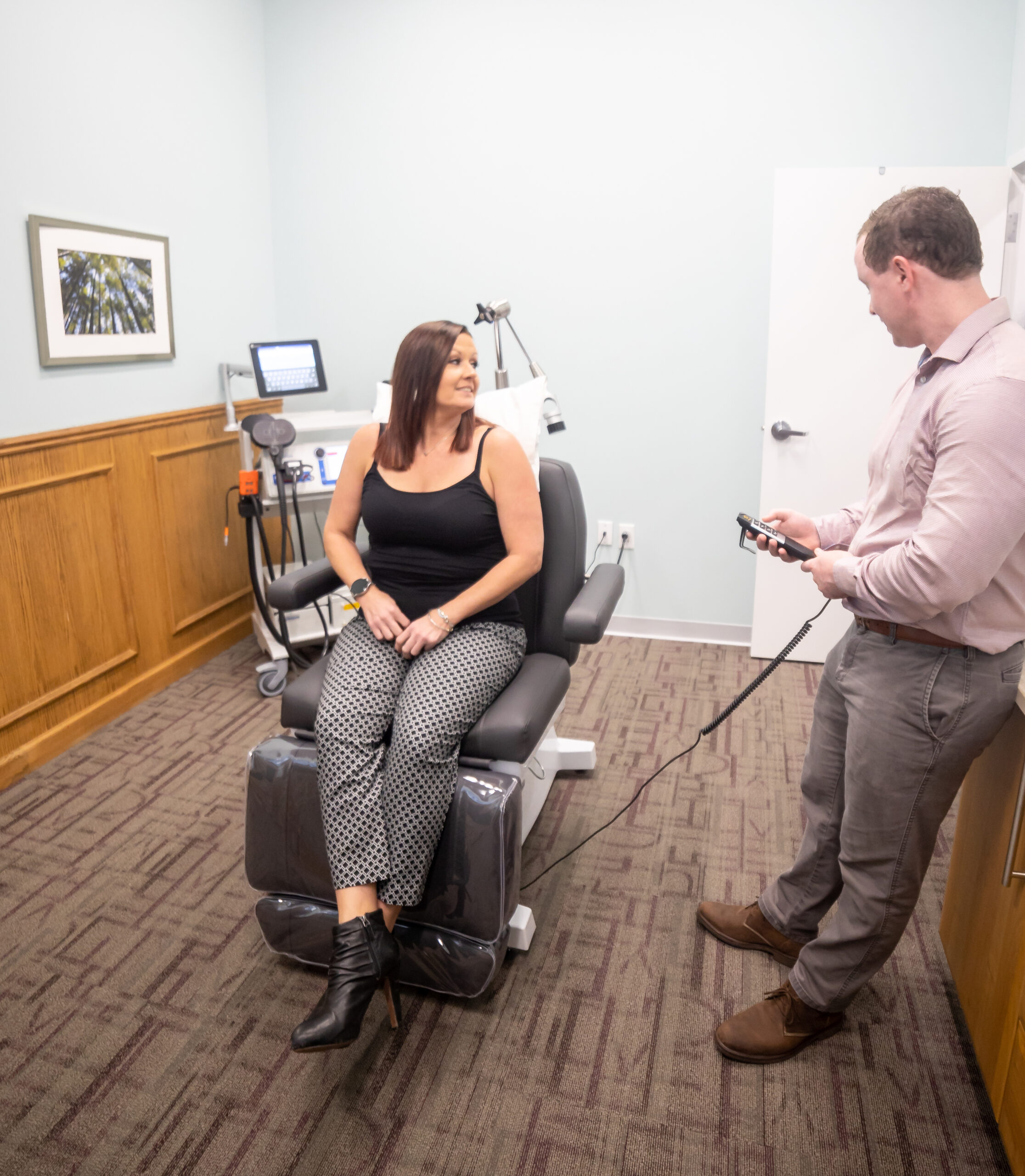One of the most common questions we get is “What can I expect when I start TMS?” It’s perfectly normal to have some anxiety whenever you are starting something new and unknown. TMS is no different, but it’s the beginning of a whole new journey. This quick article goes over what you can expect during the TMS evaluation, mapping and daily sessions.
Evaluating Candidates for TMS Therapy: What to Expect
When considering TMS therapy, the first step involves a thorough evaluation with a psychiatrist. This evaluation is critical to ensure that TMS is a safe and appropriate treatment choice for you.
During the evaluation, the psychiatrist will discuss your medical history, mental health history, and current symptoms. They’ll pay particular attention to any history of seizures or head injuries, as these can potentially increase the risk of side effects from TMS.
The doctor will also want to know about any metal implants in or near your head, such as cochlear implants, stents, or aneurysm clips. These contraindications can interact with the magnetic fields generated by the TMS device, making the treatment unsafe.
Medications are another important topic. Certain drugs, especially those affecting the central nervous system, can influence how your brain responds to TMS. You should be prepared to provide a complete list of all medications you are taking, including over-the-counter drugs and supplements.
The psychiatrist will also evaluate your current state of mental health. They’ll be looking out for symptoms of depression or other mental health conditions, and assessing the severity of these symptoms.
The aim of this evaluation is to create a comprehensive picture of your health status to determine if TMS therapy is right for you. This careful and holistic approach helps ensure that the treatment plan developed is both safe and effective, tailored specifically to your unique needs. Always remember, open communication with your healthcare provider is key for the success of any treatment.
Navigating the Course: What to Expect During a TMS Therapy Mapping Session
A crucial part of TMS therapy involves a process known as ‘brain mapping’. This procedure is instrumental in tailoring the therapy to your individual needs, ensuring that the treatment is targeted and effective. Here’s what you can expect during a TMS therapy mapping session.
Once your evaluation is complete and you are deemed a suitable candidate for TMS therapy, the psychiatrist will schedule a mapping session. This process locates the precise area of your brain that will be targeted during your treatment. This area is often part of the prefrontal cortex, which is known to be involved in mood regulation.
When you arrive for your mapping session, you’ll be seated comfortably in the TMS chair (similar to a dentist chair). The first part of the mapping session will involve taking various measurements of and around your head. Typically this includes the circumference of your head, the distance between both ears over the top of your head, and the distance from the bridge of your nose to the base of your skull. These measurements determine the approximate area the psychiatrist will use the coil to determine your motor threshold (explained below).
The TMS coil, a device that generates the magnetic pulses, will be positioned on your head. But before the therapy starts, the doctor needs to establish your ‘motor threshold’. This is the lowest amount of magnetic energy needed to stimulate the motor cortex (the area of the brain responsible for movement) to make your thumb twitch, an indication that the motor cortex of your brain is being stimulated. Once this area is located, the psychiatrist will know the exact spot to treat on the prefrontal cortex.
This motor threshold is unique to each person, and it’s important because it helps the doctor calibrate the amount of energy needed for your TMS sessions. Too much energy could increase the risk of side effects, while too little might not have the desired therapeutic effect.
During this process, you might feel a tapping sensation on your scalp. It’s a unique sensation but it is usually not painful. Most patients report getting used to the feeling fairly quickly.
Once your motor threshold is determined, the TMS coil is then repositioned to target the specific part of your brain that will be treated during your sessions. The distance from the motor cortex to this area is often calculated as a proportion of your head size, ensuring a precise and personalized treatment plan.
Keep in mind that mapping doesn’t need to be repeated before each session. The information gathered during this initial session will be used for your future treatments. However, re-mapping may be done during the course of your treatment if the doctor determines it to be necessary.
The entire mapping session generally lasts between 30 minutes to an hour. It’s a vital part of your TMS journey, ensuring that your therapy is not only effective but also safe. Always remember, your healthcare team is there to guide you every step of the way. They are available to answer your questions and address your concerns, making the process as comfortable and reassuring as possible.
Daily Rhythm: What to Expect During Your TMS Therapy Sessions
Transcranial Magnetic Stimulation (TMS) has become a transformative tool in the fight against depression. But, what does a typical session look like? Let’s delve into the details of your daily TMS therapy sessions.
A TMS session usually lasts from as little as 3 minutes to 20 minutes, depending on your personalized treatment plan. Initially, you might find the sensation of TMS unfamiliar – a rhythmic tapping on your scalp. Most people become accustomed to this feeling within the first week of sessions, likening it to a gentle tapping on the head.
During these sessions, you remain awake and alert. This means you can engage in various activities like playing on your phone, answering emails, or watching TV. Some patients prefer to relax, listen to music, or even meditate. It’s your time, so you’re free to use it in a way that works best for you.
Building a relationship with your TMS technician is another integral part of the therapy. They become a consistent part of your daily routine, providing a comforting and familiar presence. They’re not just there to administer the treatment, but also to monitor your progress, answer your questions, and offer support.
Part of that monitoring includes daily questions and periodic reevaluation of your depression severity scores using questionnaires. This allows you and your healthcare team to track your progress and adapt your treatment plan as necessary.
In short, your daily TMS sessions become a structured part of your day, a time to focus on your well-being. You’re not just receiving treatment, you’re actively participating in your path to recovery. The journey may not always be easy, but remember, you’re not alone, and each day brings you one step closer to finding your balance.
Life After Graduating TMS Therapy
Getting used to living without the burden of depression can be daunting in and of itself. Some TMS patients say they haven’t felt this good in 20 plus years. That can be hard to get used to. Its like being released from prison from an unlawful conviction. Entire articles will be devoted to this topic, but for starters:
Celebrate Small Victories: Often, we overlook small achievements while focusing on big goals. Celebrate minor victories, like waking up early, engaging in a hobby, or having a positive social interaction. These steps signify progress and can help build a positive outlook.
Maintain a Healthy Lifestyle: Balanced nutrition, regular exercise, and adequate sleep are critical for maintaining mental health. Explore new foods, find a physical activity you enjoy, and create a sleep routine that ensures you get enough rest.
Pursue Interests and Hobbies: Now that you’re living without the heavy cloud of depression, it’s a great time to explore old interests or discover new ones. This could be art, cooking, reading, gardening, or anything that brings you joy and fulfillment.
Reconnect with Friends and Family: Depression often leads to isolation. Reach out to your loved ones, spend quality time with them, and let them share in your journey of recovery. Social connections can greatly enhance your sense of well-being.
Practice Mindfulness and Gratitude: Mindfulness exercises, like meditation or yoga, can help you stay present and appreciative of the progress you’ve made. Cultivate a habit of recognizing and being grateful for the positive aspects of your life.





